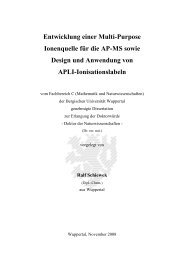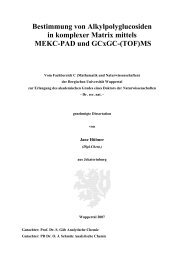The Influence of Oxidative Stress, Carcinogens and Cloning on DNA ...
The Influence of Oxidative Stress, Carcinogens and Cloning on DNA ...
The Influence of Oxidative Stress, Carcinogens and Cloning on DNA ...
Create successful ePaper yourself
Turn your PDF publications into a flip-book with our unique Google optimized e-Paper software.
1.3.3.2 Aristolochic acid (AA)<br />
29<br />
Introducti<strong>on</strong><br />
Not <strong>on</strong>ly the envir<strong>on</strong>mental polluants or food derivative heterocyclic amines form <strong>DNA</strong> adducts,<br />
but also some fungal products c<strong>on</strong>tribute to carcinogenesis (305) such as aflatoxin B1<br />
which is a fungal metabolite produced by Aspergillus flavus <str<strong>on</strong>g>and</str<strong>on</strong>g> related fungi that grow <strong>on</strong><br />
improperly stored foods (306-309) . In additi<strong>on</strong>, aristolochic acid (AA) is a natural product recorded<br />
for its carcinogenicity.<br />
Chinese herbs nephropathy (CHN) (310, 311) is a recently described subacute interstitial fibrosis<br />
which progress rapidly causing permanent kidney damage, including end-stage <str<strong>on</strong>g>of</str<strong>on</strong>g> kidney fail-<br />
ure <str<strong>on</strong>g>and</str<strong>on</strong>g> upper urothelial cancer. It is named also AA nephropathy (312, 313) characterising<br />
nephrotoxicity disease which is associated with the prol<strong>on</strong>ged use <str<strong>on</strong>g>of</str<strong>on</strong>g> chinese herbs in the form<br />
<str<strong>on</strong>g>of</str<strong>on</strong>g> slimming pills (312, 314-316) . This syndrome has been traced to aristolochic acid (AA) which<br />
is a major alkaloid <str<strong>on</strong>g>of</str<strong>on</strong>g> isochinoline group extracted from Aristolochica species (316) <str<strong>on</strong>g>and</str<strong>on</strong>g> other<br />
plant species. It is c<strong>on</strong>sisting <str<strong>on</strong>g>of</str<strong>on</strong>g> a mixture <str<strong>on</strong>g>of</str<strong>on</strong>g> structurally related nitrophenanthrene derivatives,<br />
AAI <str<strong>on</strong>g>and</str<strong>on</strong>g> AAII (Fig. 14). <str<strong>on</strong>g>The</str<strong>on</strong>g>y form <strong>DNA</strong> adducts after metabolic activati<strong>on</strong> by simple<br />
reducti<strong>on</strong> <str<strong>on</strong>g>of</str<strong>on</strong>g> the nitro group (315, 316) .<br />
O<br />
O<br />
COOH<br />
OMe<br />
NO 2<br />
Aristolochic acid I Aristolochic acid II<br />
C 17H 11NO 7<br />
Mol. Wt.: 341.27<br />
O<br />
O<br />
C 16H 9NO 6<br />
Mol. Wt.: 311.25<br />
COOH<br />
Figure 14: Chemical structures <str<strong>on</strong>g>of</str<strong>on</strong>g> aristolochic acid I (8-methoxy-6-nitro-phenanthro[3,4 -<br />
d][1,3]dioxole-5-carboxylic acid) <str<strong>on</strong>g>and</str<strong>on</strong>g> aristolochic acid II (6-nitro-phenanthro[3,4d][1,3]dioxole-5-carboxylic<br />
acid)<br />
Aristolochia is a large genus <str<strong>on</strong>g>of</str<strong>on</strong>g> plants with over 500 species bel<strong>on</strong>ging to the Birthwort family.<br />
At least 180 kinds <str<strong>on</strong>g>of</str<strong>on</strong>g> the plant family Aristolochiaceae are well-known over the world. It<br />
was <str<strong>on</strong>g>of</str<strong>on</strong>g> great interest by the ancient Egyptians, Greeks <str<strong>on</strong>g>and</str<strong>on</strong>g> Romans (317, 318) . Its nomenclature<br />
was developed from Greek words (Aristos: best) <str<strong>on</strong>g>and</str<strong>on</strong>g> (locheia: birth) meaning ‘correct delivery’.<br />
In the Indian folk medicine, it was given to women in labour to expel the placenta (319,<br />
NO 2




